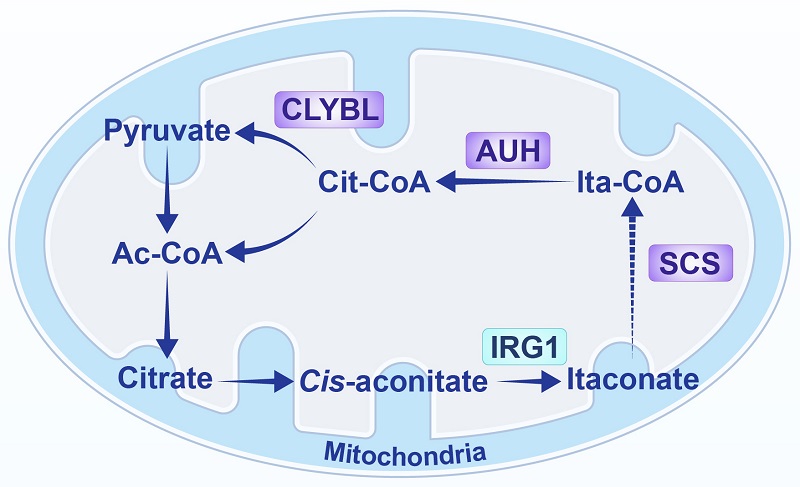Scientists Review the Role of Itaconate in Immune Responses
On November 22, 2024, a research team led by Prof. LI Xinjian at the Institute of Biophysics, Chinese Academy of Sciences, published a review article in Cell Insight. The article traces the discovery of itaconate as an immune modulator and effector molecule, describes the development of fluorescent probes for itaconate, and summarizes recent research findings on the mechanisms of itaconate transport between cells.
Itaconate is produced by the mitochondrial enzyme aconitate decarboxylase 1 (ACOD1), encoded by the immune-responsive gene 1 (IRG1), by catalyzing the decarboxylation of the tricarboxylic acid cycle intermediate cis-aconitate. Itaconate can also undergo catabolism within mitochondria (Figure 1).

Fig. 1 The metabolic pathway of itaconate in mammalian cell mitochondria
(Image by LI Xinjian's group)
Previous studies by Li's team have demonstrated that itaconate can activate the transcription factor TFEB through alkylation, inducing lysosome biogenesis and enhancing the antibacterial innate immune capability of macrophages. Myeloid cells, such as macrophages, can produce itaconate and secrete it extracellularly, suggesting that itaconate generated by myeloid cells might be transported to non-immune cells to exert its functions.
To test this hypothesis, the researchers developed a genetically encoded fluorescent probe for itaconate, called BioITA. Using BioITA for high-throughput screening of cells expressing a CRISPR gRNA library targeting membrane proteins, they identified ABCG2, an ATP-binding cassette transporter, as the extracellular transporter, and SLC13A3, a solute carrier family protein, as the intracellular transporter of itaconate.
Functional studies revealed that extracellular itaconate release mediated by ABCG2 limits lysosome biogenesis and antibacterial innate immunity in macrophages. Conversely, intracellular uptake of itaconate via SLC13A3 enhances the antibacterial innate immunity of the liver. These findings elucidate the molecular mechanisms of itaconate's intercellular transport (Figure 2) and suggest that itaconate acts as an immune signaling metabolite.

Fig. 2 The intercellular transport mechanism of itaconate
(Image by LI Xinjian's group)
The researchers emphasize that the interplay between metabolic changes and immune cell activation is critical for regulating the host's immune response. Beyond serving as a traditional energy source and biosynthetic precursor, metabolites can function as signaling molecules to transmit information between cells. The discovery of the intercellular transport mechanisms of itaconate highlights its role as a metabolite with immune messenger properties.
Based on current research progress, the researchers propose that itaconate is an immune signaling molecule that plays a vital role in host inflammatory responses and immune defense.
Article link: https://doi.org/10.1016/j.cellin.2024.100224
Contact: LI Xinjian
Institute of Biophysics, Chinese Academy of Sciences
Beijing 100101, China
Email: lixinjian@ibp.ac.cn
(Reported by Prof. LI Xinjian's group)

